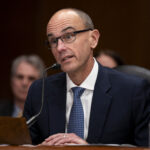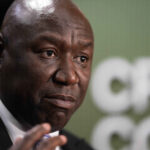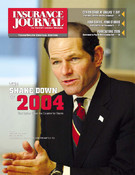Texans like to say everything is bigger in Texas, but economist Robert P. Hartwig came to Dallas to explain that big numbers alone aren’t worthy of celebration. The Texas insurance industry, for example, enjoys big premium volume but profits are faltering.
Texas is a leading generator of property and casualty premiums in the global market, Dr. Hartwig, senior vice president and chief economist for Insurance Information Institute, assured those attending the Nov. 23 All Industry Day–an annual event sponsored by the Independent Insurance Agents of Dallas (IIAD), the Dallas Chapter of Chartered Property & Casualty Underwriters (CPCU) and the University of North Texas.
“If Texas were its own country–again,” it would be the eighth largest insurance market, Hartwig said. The top three generators are the United States, followed by Japan and Germany. California leads the nation in market share, producing 13 percent of the P/C market, with Texas and New York tied for second place producing 7.3 percent each.
But, if the property and casualty market in Texas were a company, it would not attract much excitement on Wall Street. “Texas historically has been a bad investment for insurers.”
Return on equity in 2003 averaged about 2 percent for the Texas P/C industry, lagging the P/C industry nationwide. By comparison, Dell realized a 42.1 percent ROE followed by Radio Shack with 38.8 percent ROE. Returns in Fortune 500 companies since 1990 outperformed the Texas P/C market by 231 percent, he said.
Yet, despite relatively anemic returns, media commentators and some politicians insist that insurance companies are “obscenely profitable” and “rolling in dough,” Hartwig said, and therefore, the industry should scale back its prices. However, no one suggests Dell or Radio Shack should do the same thing, he pointed out.
Nationwide, profitability in P/C insurance is “incredibly cyclical,” Hartwig noted, but in recent years “the peaks are nowhere near as high as before.” Although the industry was on track to set record underwriting profits in 2004, the best year since 1978, that hope was derailed when four hurricanes hit Florida.
To add insult to injury this year, allegations of mismanagement and fraud among certain brokers surfaced in October. The announcement of fraud investigations spawned “headlines from hell,” Hartwig said, fueling media accusations that the industry is guilty of all manner of wrongdoing.
Beyond the broader forces affecting the industry’s profitability, Texas has its own special challenges. The rate of premium growth in Texas is in line with the nationwide P/C industry, but Texas has been a dramatic under performer in terms of profits.
“The below-average profitability in Texas is weighed down by homeowners insurance. Nationally, homeowners [insurance profitability] is terrible; in Texas it’s among the worst,” he said.
Hartwig illustrated his point this way: An investor who put $100 in the overall stock market in 1990 would have $460 today. But, $100 invested in the Texas homeowners’ insurance market in 1990, now would be worth only $24.
On a brighter note, Texas’ mold problems appear to be “on the mend,” he said, noting that losses began to taper off last year. Mold exclusions also mitigated financial exposure.
Windstorms pose another natural threat in Texas. The state trails only Florida for exposure to wind storm risk, yet Texas is far less prepared to weather a hurricane than the Sunshine State, which has a “culture of strengthening building codes,” Hartwig said.
Lack of tort reform hurts the Texas market, Hartwig said, because three of the country’s “judicial hellholes” are located in Texas. “Two of the largest jury awards in the past few years came out of Texas.” The tort environment “guarantees long-term problems,” he predicted.
Tort reform, TRIA and more
During a roundtable discussion with P/C industry executives and a U.S. Congress-man, Parker Rush, CEO of Republic Insurance Co., said the industry should do more to promote tort reform. “We’ve done a lousy job explaining to the public” that they end up paying for jury awards.
Robert Ramsower, CEO of Employers General, echoed Parker’s statements. “The mold situation is a prime example in south Texas.” As a commercial carrier, Employers General is affected by lawsuits alleging mold contamination. “We are well behind the curve on educating the public [about who pays for exorbitant awards]. The industry also needs to be more proactive in the legislative process.”
Dinos Iordanou, CEO of Arch Capital Group, suggested the industry should stop hoping for “a silver bullet” from the federal government and instead focus on reforms at the state level. “Where we have elected fair-minded judges in the past 10 years, we have made the playing field more level as a result.”
But, he added, “we have to have our story understood, how damaging the tort system is to businesses in the U.S.” Compensating “potentially injured parties,” as in asbestos cases, is a slippery slope, he said. “It’s not solely an insurance issue. It will make the U.S. uncompetitive eventually.”
Congressman Jeb Hensarling, a GOP member of the House Financial Services Committee, called the “explosion of liability exposure” one of the biggest threats to American companies. Though tort reform failed in the 108th Congress, he said, “I think you’ll see it again.”
When California, for example, determined that 10 to 15 percent of health care inflation was attributable to frivolous lawsuits, he said, the state enacted a statute to limit attorneys’ fees and to cap damages awarded in malpractice cases.
“I don’t often hold California up as a model,” Hensarling said, but it has demonstrated that such measures can be used to protect an industry. “I believe we should explore caps on lawsuits,” he said, adding, “for every reform there are 1,000 reasons not to do it.”
On a federal level, Hensarling said, “an education effort would be helpful to get across the message” that insurance plays an important part in the economy, he told the audience. “The new reality is that to be successful you have to also be successful in the halls of Congress … Democracy is a participatory sport.” He mentioned realtors as a group with a persuasive presence in Washington, and perhaps a good industry model to examine.
Iordanou noted that the insurance industry “works as a catalyst, bringing capital together to create business.” The industry also provides jobs for 2 million people. The “economy would come to a halt if insurance wasn’t available,” he said. For that reason, government should act as a “backstop” when the risk is incalculable, as in the case of terrorism. “I am hoping TRIA can be renewed,” he said, referring to the Terrorism Risk Insurance Act of 2002, which is set to terminate Dec. 31, 2005.
Hensarling told the group they should be “cautiously optimistic” that the next Congress will approve an extension, for maybe two years at most. “It continues to be high on the priority list.” In the 108th Congress, he said, the House supported a bill to extend to Act, but the Senate and House leadership was “not enthused.” He added, “I concluded that more time was needed to see if the market could find some stability.”
The topic of ratings came up throughout the day. Iordanou noted that from 1997 to 2001, during the “worst recent underwriting years, we saw the largest number of upgrades in ratings,” indicating that the ratings system is “flawed” and that ratings companies are using outdated methods to determine ratings. “They are focusing on the wrong things.”
Rush suggested that factors such as how well an insurer is paying claims, IB&R (incurred but not recorded) “line by line as compared to its peers,” and pricing discipline should be considered.
Healthy or not?
On a separate panel titled “Evaluating an Insurance Company’s Health,” Michael J. Barry, managing director at Fitch Ratings, explained that ratings companies use models as one tool in determining stability, but “a model is only as good as the information that goes into it.” Wall Street looks “too heavily at financial risk,” he said, whereas rating companies look also at operational risk, “what are insurers selling, to whom and how.”
The fact that rating services apply different processes to evaluate insurers “adds value” for the user, said Jeffrey Berg, vice president and senior analyst at Moody’s. There’s no one-to-one correlation between a single criteria and a company’s rating, he explained, but instead ratings depend on a composite quantitative and qualitative analysis of many factors, including the company’s financial health (profitability, reserve adequacy) and the regulatory environment for the overall industry.
Barry advised independent agents to evaluate companies they deal with by getting ratings from two or three ratings agencies. That information is readily available on the Internet or from the insurer.
The Texas Department of Insurance on its Web site (www.tdi.state.tx.us) posts the ratings of companies relative to their peers and includes links to ratings services, said Texas Insurance Commissioner José Montemayor.
Topics USA California Carriers Texas Property Casualty Market
Was this article valuable?
Here are more articles you may enjoy.


 McKinsey Plots Thousands of Job Cuts in Slowdown for Consulting Industry
McKinsey Plots Thousands of Job Cuts in Slowdown for Consulting Industry  Insurance Covers Settlement Paid by Stocks Instead of Money: Delaware High Court
Insurance Covers Settlement Paid by Stocks Instead of Money: Delaware High Court  Trump Administration Turning to Private Firms in Cyber Offensive
Trump Administration Turning to Private Firms in Cyber Offensive  Florida Jury Returns $779M Verdict for Family of Security Guard Killed at Gambling Cafe
Florida Jury Returns $779M Verdict for Family of Security Guard Killed at Gambling Cafe 


